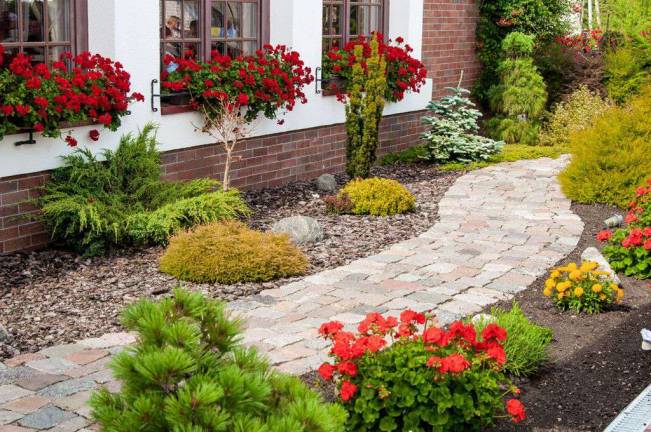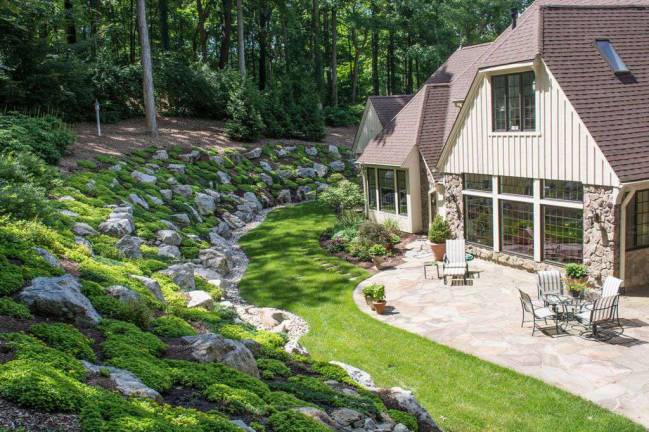Landscaping for Unpredictable Weather


If you think climate change and extreme weather conditions have been tough on human beings, just imagine being stuck outdoors, naked to the elements 24/7.
Such has been the lot of live landscaping staples like grass, trees, shrubs, plants and flowers, which have had to withstand the fury of names storms, such as Sandy, Irene, and other bullies in recent years.
Indeed, from extended droughts and blistering hot summers to 100-year floods and bomb cyclones, Mother Nature has created a lot of extra challenges lately for homeowners seeking a scenic setting across their yards.
“Landscaping has always been at the mercy of weather conditions, but it appears to have gotten more difficult in the past few years,” says Ronna Moore, owner of Fairy Homes and Gardens. “Climate change causes big global problems, such as rising sea levels, increasing air and sea temperatures and extreme weather, but it is also causing challenges in the yard.”
Case in point
Jon Feldman, owner of G. Biloba Gardens, says changing environments have disadvantaged what were previously flourishing species by making them more vulnerable to disease.
“Also, non-native, invasive plants spread more rapidly and can choke out ornamental shrub beds,” Feldman says. “They generally have less water requirements than native species, allowing them to survive extreme drought conditions. On the opposite end of the extreme weather cycle, flooding can cause erosion of top soil, depleting the available supply of nutrients that ornamental plants need in greater quantities than invasive species. Shrubs, perennials and annuals particularly suffer.”
Angie Hicks, founder of Angie's List, says even the most resilient plants have their limits.
“Hardy plants have the ability to survive cool temperatures and frost, but they aren't invincible against extreme heat, wind and other conditions,” she says.
For all these reasons, homeowners now have to put more thought and planning into landscape design, “from the materials they use to the plants they plant,” Hicks adds.
Your defense against the elements starts with choosing sturdier botanical breeds whenever possible.
These can include wild geraniums, oregano, chives, poppies and daffodils, suggests Hicks. Other worthy candidates are drought-resistant species like Lewisia, Angelina sedum, red bird of paradise, blue star juniper, Russian sage and yellow alyssum.
Go native
“Plant species that are indigenous to your specific area or region,” recommends Cassy Aoyagi, president of Form LA Landscaping. “Native plants have spent millions of years adapting to thrive in your soils and climate and will have the best chance of adapting yet again, requiring no chemical fertilizers or pesticides and much less fuss.”
In addition, think twice about planting species that could lead to a lot of toil and regret in these times of extreme weather fluctuations - including arborvitae, white pine and birch trees.
“With more humid and wet weather, fungus becomes a greater issue than in decades past. For that reason, I am not a fan of roses, which require fungicides and other chemical applications to retain their aesthetic appeal,” Feldman says.
Plan on better plant protection, too.
“If you predict that harsh sun or heavy rains will become problematic, place your plants nearer to your home or other greenery to help protect them,” advises Missy Henriksen, vice president of public affairs for the National Association of Landscape Professionals. “Also, consider adding an overhead canopy above prized plants or an outdoor heater on your patio to take the chill off plants positioned there.Apply fresh mulch around trees and planting beds, as well, which can help them retain moisture and survive during drier seasons, prevent weeds and supply nutrients back into the soil.”
Many mulch materials are on the market, including peat moss, gravel, shredded hardwood, and pine nuggets; if you're not sure which is best for your needs, consult a landscape professional, Henriksen adds.
Read the fine print
“Do not choose plants that are borderline hardy in your zone. Read the labels and follow the planting instructions,” Moore says.
If you cherish plants and lawns that require more consistent watering, consider investing in an underground irrigation system.
“If plantings are large enough, this is essential to maintain their health and appearance for years, although it's a significant added cost,” Feldman says.
Lastly, remember that no garden, lawn or yard is 100 percent invulnerable to the ravages of extreme weather.
“Homeowners can do everything they can to plant the right species and use the most durable materials, but weather can be so unpredictable,” Hicks says. “Keep in mind, also, that all plants require some maintenance at some point.”
And a foliage facelift from time to time, too.
“When plants become overgrown or too large for their location, a change is probably necessary,” Henriksen says.